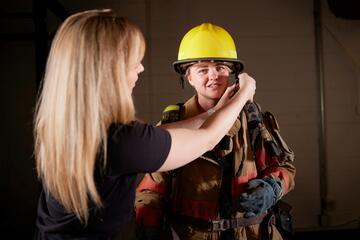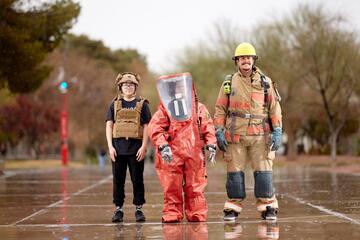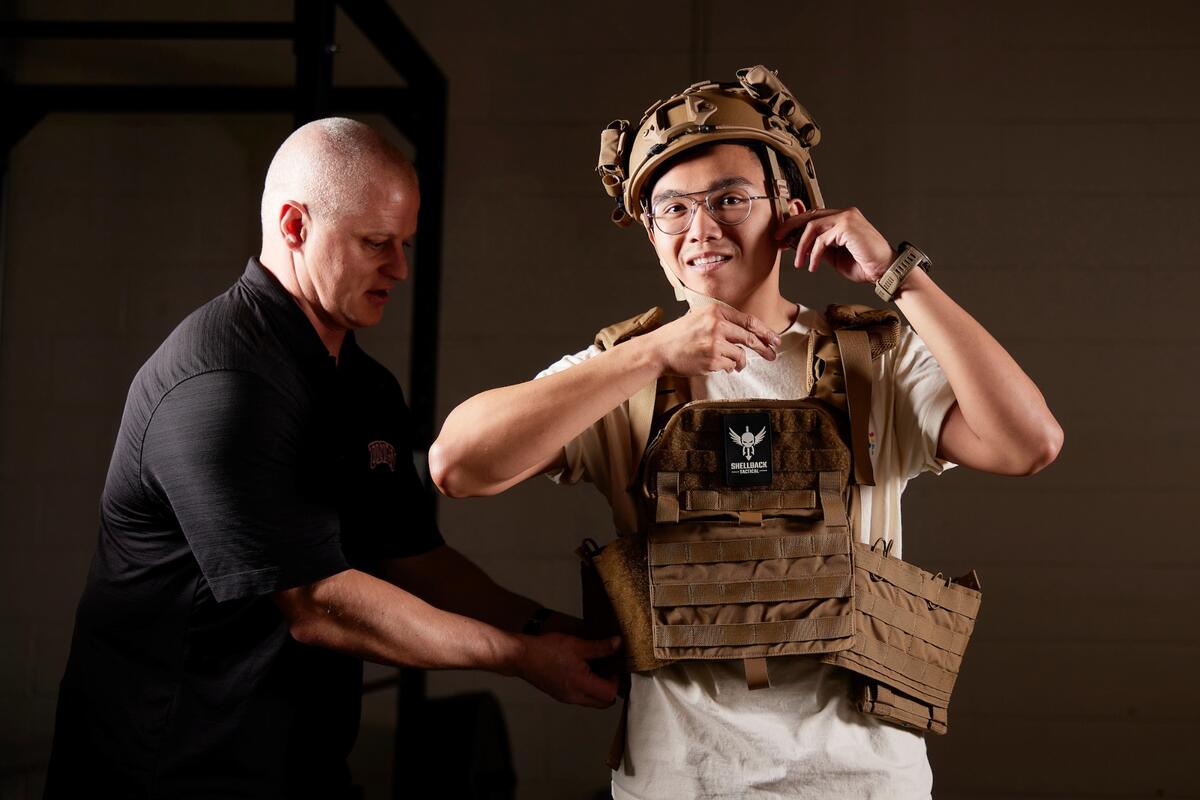On TV and in movies, actors can make the work of hauling gear in bulky uniforms look effortless, whether it’s a rifle-toting title character in American Sniper, the first responders on Chicago Fire, or the detectives with their gun belts, radios, and parkas in True Detective: Night Country.
Their real-life counterparts, however, exert a significant amount of strength and energy to complete their jobs.
How does the weight of their equipment affect their job performance? Firefighters can carry about 50 additional pounds of personal protective equipment and self-contained breathing apparatus. A light infantry soldier may carry 60-100 pounds of additional weight.
How might extreme heat and brutal cold alter their body temperatures? And how do those elements affect them in the line of duty?
While these professions make for highly sought-after Hollywood scripts, there is critical science behind improving their actual performance.
Understanding that science is the goal of First Responder and Military Human Performance, or Kinesiology 411, offered in UNLV’s School of Integrated Health Sciences. While most people associate human performance with elite athletes, human performance is something that makes a difference in our everyday lives.

The Course: First Responder and Military Human Performance
This kinesiology course offers an in-depth study of human performance optimization for physically demanding professions, including first responders and the military.
Students learn how people can best train for these professions to maximize their performance with a special emphasis given to job task analysis and environmental concerns. They also learn how to reduce injury risk.
This is a hybrid-model class. Students review online content and write about that content. They are then required to come to campus once a week for a 75-minute discussion or lab exercise. This gives them the chance to try on the equipment and learn first-hand how it affects performance.
Who teaches this class?
This class is taught by Brian Schilling, a professor in Kinesiology and Nutrition Sciences with expertise in strength and conditioning. He is also the director of UNLV's Physically Demanding Professions Research Laboratory, located within the School of Integrated Health Sciences. Schilling’s lab focuses on the physical demands among military, law enforcement, and fire and rescue personnel, and how to best train to meet the demands of their professions.
Kathryn Bell, a doctoral student in kinesiology and nutrition sciences, also teaches the course. She is a member of the U.S. Army National Guard and has a master’s in applied physiology.
“I have had several incredible experiences in the military that have complemented many of the topics I teach in class,” she said. “I have not only gotten to experience so many aspects of what I teach from a military perspective, but I also work with other soldiers whose day jobs are in fire and law enforcement. I regularly hear their stories and experiences, and have even integrated the training they have done within their departments into my lectures.”
Who’s taking it?
Kinesiology 411 is taken by undergraduate students from the Department of Kinesiology and Nutrition Sciences. Kinesiology 611 is the same class offered to graduate-level students pursuing a master’s degree.
“To foster small group discussions, I typically take between 12 and 18 students each cohort so they can work in small groups of three,” Schilling said. “I tend to get plenty of students who are veterans or who are connected to law enforcement or fire. This past semester, I had a veteran, two paramedics, and someone who wanted to go into the fire academy. I also had an active Metro police officer in my class. These students really add to the conversation because they are able to speak from their unique experiences.”

Where did the inspiration to create this class come from?
Schilling developed the class after talking with friends who work in these fields. “I asked them what they would want students to know who go into the same fields,” Schilling said. “Trying to tie in the environmental concerns with human performance is very unique, as athletes typically don’t see the same extremes in the environment. We talk about heat, altitude, pollution, cold air, underwater diving, etc.”
Infusing the class with hands-on experience was especially important to Schilling. Students can look at the equipment that professionals have to wear on a daily basis, but putting them on creates an entirely different perspective on how the weight and other elements can affect performance.
“On several occasions, I’ve heard students say that their perception of military, fire, and law enforcement has drastically changed from what they originally thought the jobs entailed — and much of that has to do with the Hollywood perception of these careers,” Bell said.
What are students surprised to learn in this class?
While the first impression might be the physicality that the jobs require, Schilling said that students are surprised to learn that these professions also require excellent communication skills.
“You cannot do these professions if you don’t communicate,” he said. “These are human-based professions and you have to be able to communicate or you won’t make it.”
Bell said that students are also surprised to learn that military personnel are incredibly diverse, serving in a wide range of roles — it’s not all elite warfighting as depicted in most movies. It’s the same misperception of law enforcement.
“Many students are shocked to hear that police officers spend a lot of their time in their vehicles with integrated short bursts of high-intensity movement. That imposes a different level of musculoskeletal stress compared to the other tactical professions,” she said. “It’s really fun to show the realities of these professions and see our students gain a whole new appreciation for those who work within them.”
Which careers does this kinesiology class help prepare students for?
This class is both an integration of physiology and biomechanics information that students have studied in the kinesiology degree, as well as an introductory course to prepare students for positions in "tactical human performance" fields. Those fields include dietitians, strength and conditioning professionals, psychologists, and scientists.
While some entry-level positions are available for graduates with a bachelor’s degree, oftentimes advanced degrees and certifications are required. As a top-tier research university, UNLV offers a full slate of graduate academic programs to develop this workforce.
How does this class connect to UNLV research?
As director of the Physically Demanding Professions Research Laboratory, Schilling has received federal funding from the Department of Defense to examine a soldier’s performance after blood donation, as they might have to do when deployed.
Schilling has collaborated with other departments in the School of Integrated Health Sciences on research studies inside the lab, including:
- The Effect of Body Armor on Pulmonary Function Using Plethysmography
- Potential utility of a loaded treadmill protocol for tactical athletes
- Musculoskeletal Injury Concealment in the Reserve Officers’ Training Corps: A Survey of Cadets’ Reporting Behaviors
“Our lab has a responsibility to provide up-to-date, actionable information for our stakeholders,” Schilling said. “In turn, Kinesiology 411 can help make sure future practitioners are well positioned to be evidence-led in their professions.”



